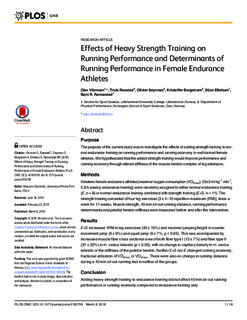| dc.contributor.author | Vikmoen, Olav | |
| dc.contributor.author | Raastad, Truls | |
| dc.contributor.author | Seynnes, Olivier R. | |
| dc.contributor.author | Bergstrøm, Kristoffer | |
| dc.contributor.author | Ellefsen, Stian | |
| dc.contributor.author | Rønnestad, Bent R. | |
| dc.date.accessioned | 2017-01-23T09:55:34Z | |
| dc.date.available | 2017-01-23T09:55:34Z | |
| dc.date.issued | 2016-03-08 | |
| dc.identifier.citation | PLoS ONE. 2016, 11, 1-18. doi: http://dx.doi.org/10.1371/journal.pone.0150799 | nb_NO |
| dc.identifier.uri | http://hdl.handle.net/11250/2428007 | |
| dc.description.abstract | Purpose: The purpose of the current study was to investigate the effects of adding strength training to normal endurance training on running performance and running economy in well-trained female athletes. We hypothesized that the added strength training would improve performance and running economy through altered stiffness of the muscle-tendon complex of leg extensors. Methods: Nineteen female endurance athletes [maximal oxygen consumption (VO2max): 53±3 ml∙kg-1∙min-1, 5.8 h weekly endurance training] were randomly assigned to either normal endurance training (E, n = 8) or normal endurance training combined with strength training (E+S, n = 11). The strength training consisted of four leg exercises [3 x 4–10 repetition maximum (RM)], twice a week for 11 weeks. Muscle strength, 40 min all-out running distance, running performance determinants and patellar tendon stiffness were measured before and after the intervention. Results: E+S increased 1RM in leg exercises (40 ± 15%) and maximal jumping height in counter movement jump (6 ± 6%) and squat jump (9 ± 7%, p < 0.05). This was accompanied by increased muscle fiber cross sectional area of both fiber type I (13 ± 7%) and fiber type II (31 ± 20%) in m. vastus lateralis (p < 0.05), with no change in capillary density in m. vastus lateralis or the stiffness of the patellar tendon. Neither E+S nor E changed running economy, fractional utilization of VO2max or VO2max. There were also no change in running distance during a 40 min all-out running test in neither of the groups. Conclusion: Adding heavy strength training to endurance training did not affect 40 min all-out running performance or running economy compared to endurance training only. | nb_NO |
| dc.language.iso | eng | nb_NO |
| dc.publisher | PLOS | nb_NO |
| dc.subject | strength training | |
| dc.subject | tendons | |
| dc.subject | running | |
| dc.subject | muscle fibers | |
| dc.subject | fast-twitch muscle fibers | |
| dc.subject | slow-twitch muscle fibers | |
| dc.subject | legs | |
| dc.subject | stiffness | |
| dc.title | Effects of heavy strength training on running performance and determinants of running performance in female endurance athletes | nb_NO |
| dc.type | Journal article | nb_NO |
| dc.type | Peer reviewed | nb_NO |
| dc.subject.nsi | VDP::Matematikk og Naturvitenskap: 400::Basale biofag: 470 | nb_NO |
| dc.subject.nsi | VDP::Landbruks- og Fiskerifag: 900::Landbruksfag: 910 | nb_NO |
| dc.source.journal | PLoS ONE | nb_NO |
| dc.identifier.doi | http://dx.doi.org/10.1371/journal.pone.0150799 | |
| dc.description.localcode | Seksjon for fysisk prestasjonsevne / Department of Physical Performance | nb_NO |
